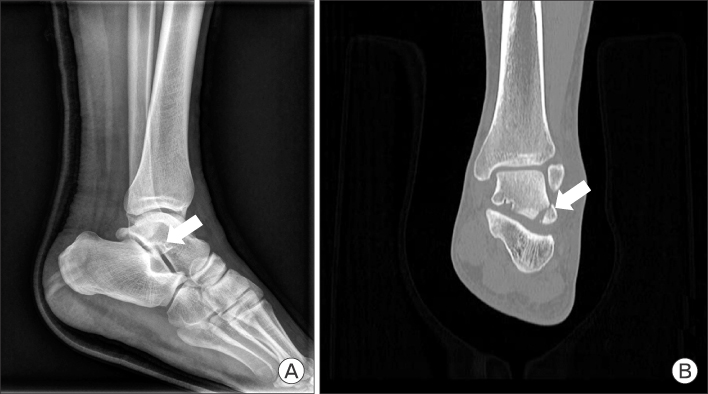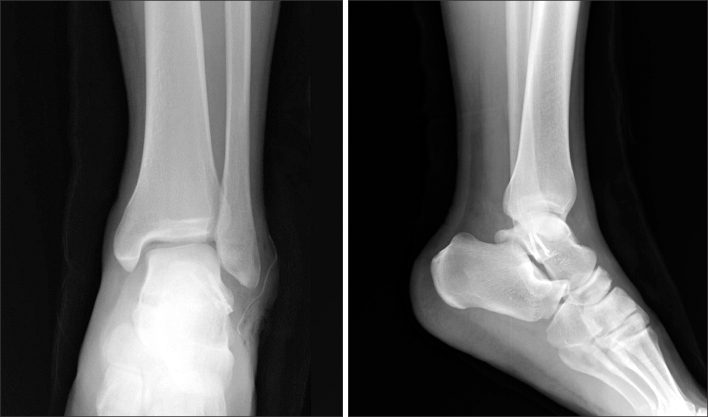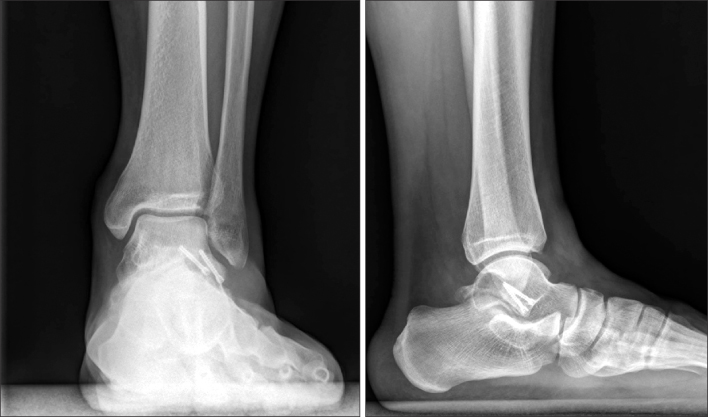Korean J Sports Med.
2017 Sep;35(2):131-134. 10.5763/kjsm.2017.35.2.131.
Snowboarder's Fracture in Cable-Wakeboarder
- Affiliations
-
- 1Department of Emergency Medicine, Cheonan Medical Center, Cheonan, Korea.
- 2Department of Orthopedic Surgery, Dankook University Hospital, Cheonan, Korea.
- 3Department of Emergency Medicine, Dankook University Hospital, Cheonan, Korea.
- 4Dankook University Hospital District Trauma Center, Dankook University Hospital, Cheonan, Korea. osdankook@gmail.com
- KMID: 2389654
- DOI: http://doi.org/10.5763/kjsm.2017.35.2.131
Abstract
- Fractures of the lateral process of the talus (LPT) are considered rare, accounting for less than 1% of all ankle injuries in the general population. These fractures are nearly 15 times more likely to occur in snowboarders. Recently, the number of population who started enjoying cable-wakeboard is increasing and this sport may cause fracture of the LPT by axial loading occur on the LPT while boarding or trick. We report on a case of involving LPT fracture during cable-wakeboard trick with successful screw osteosynthesis.
Keyword
MeSH Terms
Figure
Reference
-
1. Funk JR, Srinivasan SC, Crandall JR. Snowboarder's talus fractures experimentally produced by eversion and dorsiflexion. Am J Sports Med. 2003; 31:921–928.2. Valderrabano V, Perren T, Ryf C, Rillmann P, Hintermann B. Snowboarder's talus fracture: treatment outcome of 20 cases after 3.5 years. Am J Sports Med. 2005; 33:871–880.3. Langer P, Nickisch F, Spenciner D, DiGiovanni C. Effect of simulated lateral process talus “fracture excision” on its ligamentous attachments. Am J Orthop (Belle Mead NJ). 2009; 38:222–226.4. Barendse-Hofmann MG, Steenvoorde P, van Doorn L, Zeillemaker A. Compartment syndrome of the arm after cable-wakeboard accident. Eur J Trauma Emerg Surg. 2009; 35:74–78.5. Carson WG Jr. Wakeboarding injuries. Am J Sports Med. 2004; 32:164–173.6. Narita T, Mori A, Hashiguchi H, et al. Anterior cruciate ligament injuries among wakeboarders: a case report. J Nippon Med Sch. 2004; 71:57–62.7. Hostetler SG, Hostetler TL, Smith GA, Xiang H. Characteristics of water skiing-related and wakeboarding-related injuries treated in emergency departments in the United States, 2001-2003. Am J Sports Med. 2005; 33:1065–1070.8. Bladin C, McCrory P. Snowboarding injuries: an overview. Sports Med. 1995; 19:358–364.9. Boon AJ, Smith J, Zobitz ME, Amrami KM. Snowboarder's talus fracture: mechanism of injury. Am J Sports Med. 2001; 29:333–338.10. DiGiovanni CW, Langer PR, Nickisch F, Spenciner D. Proximity of the lateral talar process to the lateral stabilizing ligaments of the ankle and subtalar joint. Foot Ankle Int. 2007; 28:175–180.
- Full Text Links
- Actions
-
Cited
- CITED
-
- Close
- Share
- Similar articles
-
- Early experience with Dall-Miles cable grip system at femur fracture after hip arthroplasty: 3 case report
- Treatment of Periprosthetic Femoral Fractures with Cable Plate
- Do Cerclage Cables Delay the Time to Bone Union in Patients with an Unstable Humeral Shaft Fracture Treated with Intramedullary Nails?
- Cable Fixation Method for Displaced Acetabular Fracture
- A Case of Skin Burns Occurring during Laparoscopic Surgery




